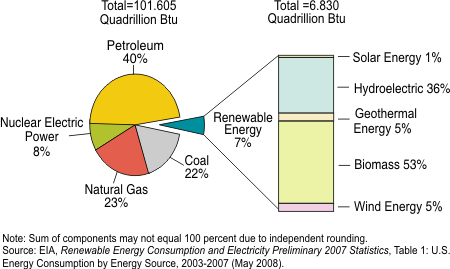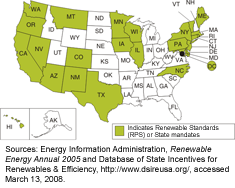
Wind-generated electricity increased by 45% between 2005 and 2006 and by 21% between 2006 and 2007, more than any other renewable source of generation in both years. These increases were due, primarily, to newly- constructed wind power plants.
Hydroelectric generation increased by 7% between 2005 and 2006, second only to wind power. However, between 2006 and 2007, hydroelectric generation decreased by 14%. These changes were primarily due to variation in the amounts of rainfall and snowfall occurring in watersheds where major hydroelectric dams are located.
Renewable Energy Plays a Role in the Nation’s Energy Supply (2007)

Renewable energy consumption decreased by about 1% between 2006 and 2007, contributing 7% of the Nation’s total energy demand, and 8.4% of total U.S. electricity generation in 2007.1
Most Renewable Energy Goes to Producing Electricity
Electricity producers2 consumed 51% of total U.S. renewable energy in 2007 for producing electricity.3 Most of the remaining 49% of renewable energy was biomass consumed for industrial applications (principally paper-making) by plants producing only heat and steam. Biomass is also used for transportation fuels (ethanol) and to provide residential and commercial space heating. The largest share of the renewable-generated electricity comes from hydroelectric energy (71%), followed by biomass (16%), wind (9%), geothermal (4%), and solar (0.2%).4 Wind-generated electricity increased by almost 21% in 2007 over 2006, more than any other energy source. Its growth rate was followed closely by solar, which increased by over 19% in 2007 over 2006.5
The United States Is Second in Renewable Electricity Production
China leads the world in total renewable energy consumption for electricity production due to its recent massive additions to hydroelectric production, followed closely by the United States, Canada, and Brazil. However, the United States consumes the most non-hydro renewable energy for the production of electricity. The United States consumes twice as much non-hydro renewable energy for electricity production as Germany and more than three times as much as Japan.6
The Share of Renewable-Generated Electricity in the United States Is Expected to Grow
The Energy Information Administration (EIA) projects that renewable-generated electricity will account for 12.5% of total U.S. electricity generation in 2030.7 This growth (from 8.4% in 2007 to 12.5% in 2030) is fueled by the rapid expansion of non-hydro renewable generation technologies that qualify to meet State mandates for renewable energy production.
However, EIA projects renewable energy’s share of total worldwide electricity generation will decrease slightly: from 18% of generation in 2005 to 15% in 2030.8 Although worldwide renewable energy is expected to increase, it will be outpaced by growth in other electricity generation sources.
Why We Don’t Use More Renewable Energy
Renewable energy sources and generating technologies are environmentally benign compared with fossil fuel and nuclear technologies, but there are two main reasons why we don’t use more renewable energy.
-
Renewable Energy is Expensive and Capital-Intensive: Renewable energy plants are generally more expensive to build and to operate than coal and natural gas plants. Recently, however, some wind-generating plants have proven to be economically feasible in areas with good wind resources, compared with other conventional technologies, when coupled with the Renewable Electricity Production Tax Credit (described below).
Renewable Resources Are Often Geographically Remote: The best renewable resources are often available only in remote areas, so building transmission lines to deliver power to large metropolitan areas is expensive.
Policies Aim to Increase the Use of Renewable Energy
Three kinds of policies to increase the use of renewable energy are:
-
Tax credits: The Renewable Electricity Production Tax Credit, a federal incentive, has encouraged a quadrupling of wind energy capacity over the past few years. EIA’s projections assume these credits will expire at the end of 2008, as provided for under current law. Extension of the credit would increase the projected growth in renewable generation.
Targets: Many States have Renewable Portfolio Standards (RPS), which require electricity providers to generate or acquire a percentage of generation from renewable sources.9 However, many RPS programs have “escape clauses” if renewable generation exceeds a cost threshold. Some States have delayed compliance and others lack enforcement procedures. As a result, States may not always meet their RPS goals. Since it is difficult to project which States will have success, EIA assumes nearly all States will meet their mandated generation.
Markets: A number of States have built Renewable Energy Certificates/Credits (RECs) into their Renewable Portfolio Standards.10 This allows electricity providers to sell renewable energy certificates/credits and use their proceeds for renewable projects. Some States have made REC markets mandatory, requiring electricity providers to produce or acquire renewable generation to reduce reliance on fossil fuels to generate electricity.
1Energy Information Administration, Renewable Energy Consumption and Electricity Preliminary 2007 Statistics, Table 1, (May 2008).
2Electrical utilities, independent power producers, and combined heat and power plants.
3Energy Information Administration, Annual Energy Review 2007, Tables 8.4b and Table 10.1 (June 2008) .
4Energy Information Administration, “Renewable Energy Consumption and Electricity Preliminary 2007 Statistics,” Table 6 (May 2008).
5Energy Information Administration, Electric Power Monthly, Table ES1.B (March 2008)
6Energy Information Administration, International Energy Annual 2005, Table E.5 and Table E.7, (June-October 2007).
7Energy Information Administration, Annual Energy Outlook 2008, Table A8 (June 2008).
8Energy Information Administration, International Energy Outlook 2008, Table H7 and Table H12 (June 2008).
9Lawrence Berkeley National Laboratory, Renewables Portfolio Standards:A Factual Introduction to Experience from the United States, (April 2007).
10U.S. Environmental Protection Agency, Green Power Partnership, Renewable Energy Certificates (RECs), accessed March 24, 2008.


